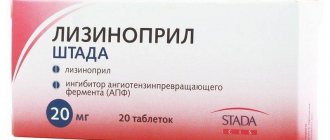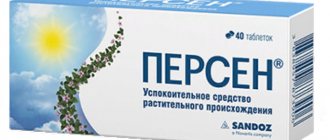Anaprilin is the first developed representative of the group of beta-blockers, the action of which is aimed at stabilizing blood pressure levels. Based on the drug intake, specialists can judge the effectiveness of new medications of this class. As a rule, patients take Anaprilin for blood pressure, but the drug has an additional antiarrhythmic effect, helping to normalize cardiac activity in people with vascular disorders. At what pressure levels can you take the drug and how to dose it correctly to avoid negative effects?
General characteristics of the product
Anaprilin for blood pressure belongs to the group of non-selective beta-adrenergic receptor blockers. The medicine has antiarrhythmic, hypotensive, antiangial properties, due to which it effectively lowers blood pressure without placing additional stress on the myocardium.
After taking a single dose of the drug, a decrease in systolic and diastolic pressure is observed, both in horizontal and vertical positions
Regular use of the medication allows you to achieve the following results:
- reduce the automaticity of the sinus node;
- reduce the excitability of the heart muscle;
- prevent the occurrence of ectopic contractions;
- normalizes the frequency of contractions of the heart muscle;
- inhibits atrioventricular conduction;
- reduces the oxygen demand of cardiomyocytes.
By blocking adrenergic receptors, anaprilin reduces blood pressure in hypertension resulting from disruption of the endocrine and excretory systems (essential and renal hypertension).
Composition and release forms
Anti-pressure tablets Anaprilin are available in dosages of the active substance in concentrations of 10 and 40 mg. To date, an injection form of the product has been developed, which is available in ampoules of 0.25%.
The medication is available in a plastic jar, which can contain 10, 40, 50, 60, 100 tablets.
The active substance in the drug is propranolol hydrochloride, which is used to lower blood pressure levels. The composition also includes additional components:
- microcrystalline cellulose;
- calcium stearate;
- talc;
- corn starch;
- colloidal silicon dioxide;
- hypromellose.
A wide range of dosages of tablet forms of the drug makes it possible for patients to select the required amount depending on the prescribed dosage regimen.
Anaprilin price, where to buy
The price of Anaprilin tablets is 10 rubles per pack of 30 pieces of 40 mg.
You can buy a package of 50 pieces of 10 mg for 20 rubles.
- Online pharmacies in RussiaRussia
- Online pharmacies in UkraineUkraine
- Online pharmacies in KazakhstanKazakhstan
LuxPharma* special offer
- Anaprilin (Anaprilin 40mg) tablet 40mg 50pcs
1480 RUR order - Anaprilin tablets 10 mg No. 50
1100 rub. order
ZdravCity
- Anaprilin tab. 40 mg No. 50Biosintez JSC
31 rub. order
- Anaprilin tab. 0.04g 50pcs LLC FC Zdorovye
65 rub. order
- Anaprilin tablets 10 mg 50 pcs. Biosynthesis OJSC
22 RUR order
Pharmacy Dialogue
- Anaprilin (tab. 40 mg No. 50) Biosynthesis OJSC
30 rub. order
- Anaprilin (tab. 10 mg No. 50) TCPP
16 rub. order
- Anaprilin (tab. 40 mg No. 112)Update of PFC JSC
78 RUR order
- Anaprilin (tab. 10 mg No. 112)Update of PFC ZAO
51 RUR order
- Anaprilin (tab. 10 mg No. 50) TCPP JSC
19 rub. order
show more
PaniPharmacy
- Anaprilin tablets Anaprilin tablets 0.04g No. 50 Ukraine, Health LLC
50 UAH. order - Anaprilin tablets Anaprilin tablets 0.01g No. 50 Ukraine, Health LLC
39 UAH order
show more
For what conditions is it used?
The blood pressure medicine Anaprilin is prescribed by a specialist when diagnosing the following conditions:
- Increased blood pressure due to essential or symptomatic hypertension.
- Treatment of coronary heart disease, angina pectoris, myocardial infarction after stabilization of vital signs.
- Irregular heart rhythm with a significant increase in heart rate.
- A disorder of the autonomic nervous system, when patients experience frequent attacks of panic attacks.
- Portal hypertension due to liver cirrhosis.
- Essential tremor.
The drug is effective in the initial stages of hypertension, therefore suitable for treating young patients
The drug is prescribed for high blood pressure, when the disease is complicated by left ventricular hypertrophy and rhythm disturbances. In addition, the drug serves as an effective prevention of migraine, which accompanies attacks of arterial hypertension.
Pharmacological properties
After taking the drug, B-adrenergic receptors are inhibited, resulting in a decrease in the intracellular concentration of calcium ions, due to which the heart rate slows down, myocardial excitability decreases, and the number of heart contractions decreases.
Due to its antiarrhythmic effect, regular use of the drug helps reduce the number of deaths after a heart attack
What pharmacological effect can be achieved with regular use of the medication:
- Hypotensive. Helps reduce minute blood volume, reduces upper and lower pressure, stimulates peripheral vessels. Reduces the activity of the renin-angiotensin system in patients with impaired renal function. The therapeutic effect is achieved 14 days after administration.
- Antianginal. Reduces the need of heart cells for oxygen, slows down the heart rate, thereby improving the capacity of the heart. However, in patients with chronic heart failure, myocardial oxygen demand may increase, which is due to increased diastolic pressure in the left ventricle.
- Antiarrhythmic. Reduces the increased activity of the sympathetic nervous system, prevents spontaneous excitability of the sinus pacemaker. By reducing the heart's need for oxygen, ischemic manifestations are reduced.
The active components are quickly absorbed into the bloodstream, due to which the pressure stabilizes in a short time. Propranolol is excreted by the kidneys in the form of metabolites.
Is there a lethal dose of Anaprilin?
A lethal outcome when using “Anaprilin” develops with the simultaneous use of 2 grams of the drug. Death occurs due to impaired blood supply in the arteries of the brain, inhibition of the vasomotor and respiratory centers. Patients die from circulatory and respiratory arrest within 2-3 hours.
Emergency assistance when the first signs of an overdose appear includes:
- rinse the stomach (stimulating vomiting is strictly prohibited);
- take enterosorbents (“White Coal”, “Smecta”);
- upon arrival of the ambulance - connection to intravenous detoxification therapy;
- antidote (antidote): Orciprenaline sulfate (“Ac”);
- glucagon intravenously at a dose of 2-5 mg (bolus), maintenance dose - 1 mg/hour;
- atropine sulfate intravenously 1 mg;
- if you have a dosing syringe: “Isadrin” 1-5 mg/hour or “Dopamine” 5-8 mcg/min.
Patients with signs of acute poisoning with Anaprilin are hospitalized in the intensive care unit.
Mechanism of action in hypertension
Before starting a therapeutic course, patients are interested in the question of the effectiveness of the prescribed medication, and does it reduce blood pressure at high levels?
The hypotensive mechanism of action of this drug is due to its ability to block beta-adrenergic receptors of the myocardium and other tissues, which is an integral part of lowering blood pressure. Inhibition of renin production contributes to decreased secretion of angiotensin 2, which leads to a decrease in blood pressure and determines the effectiveness of the antihypertensive effect of pills.
Mechanism of action of the drug for hypertension
The vasodilating effect of Anaprilin is based on the following mechanisms:
- impact on vascular receptors;
- pronounced adrenergic blocking activity;
- increases the release of nitric oxide from endothelial cells;
- expansion of the vascular lumen;
- increased production of vasodilating factors (prostaglandins, prostacyclins);
- decreased production of norepinephrine by sympathetic nerve fibers;
- decreased permeability of blood vessels to potassium and sodium ions.
Interaction
Anaprilin mutually enhances the negative effects of diltiazem and verpamil on the myocardium, inhibits the elimination of lidocaine, and prolongs the duration of action of non-polarizing muscle relaxants . The hypotensive effect is weakened when taken simultaneously with glucocorticosteroids , estrogens, and NSAIDs. The hypotensive effect is enhanced by the use of nitrates. Antacids and heparin reduce the concentration of the drug in the blood, phenothiazines and cimetidine increase it. Concomitant use with MAO inhibitors . Anaprilin increases the concentration of theophylline in plasma and slows down its metabolism.
Selection of the optimal dose
Before starting a treatment course, the patient needs to determine the daily dose of the drug, which will help eliminate hypertension and ensure stable blood pressure and pulse rate. It will also determine whether or not the drug can be used at elevated blood pressure levels when the heart rate is normal.
The dosage and frequency of administration are determined depending on the severity of hypertension, the presence of concomitant pathologies and the age of the patient
It is possible to achieve a decrease in pressure much later than normalization of sinus rhythm, which depends on the concentration of the active substance. It is recommended to take Anaprilin for high blood pressure with a full treatment course of at least 21 calendar days. The intervals between doses are 1–2 months.
The dosage of the drug depends on the indications:
- With high blood pressure. The starting dose of the drug is 80 mg, which must be divided into 2 doses. If the drug does not reduce blood pressure, the dosage is increased to 120–160 mg per day, that is, 40 mg should be taken in 3–4 doses.
- With high heart rate. At the initial stage of treatment, the daily dose is divided into 20 mg, which are drunk 3 times a day. In the absence of a therapeutic effect, the dose is increased to 80–120 mg per day.
With a normal number of heartbeats and high blood pressure, the drug is used to prevent migraine attacks and tremor. The starting dose is 20 mg 3 times a day, and the maximum allowable dose is 160 mg.
Instructions for use of the drug
"Anaprilin" belongs to a group of blockers of adrenergic receptors located in different parts of the human body: blood vessels, muscles of the heart, bronchi, uterus and prostate gland.
The interaction of the drug with sensitive cells prevents the stimulating effect of the nervous system and endocrine glands, which explains its use for idiopathic tremor and endocrinological diseases. In cardiological practice, the drug is most often prescribed to patients with coronary heart disease. The active substance helps reduce the myocardial oxygen demand and prevents remodeling (restructuring) of the heart muscle. The drug has been proven effective in reducing mortality when taken in the first hours after a heart attack.
Indications: what does the medicine help with and when is it used?
The multidirectional effect of the drug on the structures of the body determines its widespread use in medical practice. The instructions for use of "Anaprilin" highlight the following indications for prescribing the medication:
- Essential (primary, idiopathic) arterial hypertension is a disease accompanied by persistent excess of standard pressure values for no apparent reason;
- coronary heart disease (CHD) – a pathology characterized by impaired blood supply to the myocardium with typical pain in the chest during physical activity;
- angina pectoris – a chronic form of coronary artery disease;
- hypertrophic cardiomyopathy – a pathology characterized by the proliferation of muscle fibers, which reduces the volume of the chambers of the heart;
- rhythm disturbances: atrial flutter or fibrillation (atrial fibrillation), supraventricular tachycardia, extrasystoles;
- pheochromocytoma - a tumor of the adrenal tissue that synthesizes catecholamines (adrenaline, norepinephrine);
- essential tremor - “trembling” of the hands or other parts of the body for no apparent reason, familial cases are more often recorded;
- alcohol withdrawal is a complex of disorders caused by abstinence in people with alcoholism;
- infantile hemangiomas - benign tumors of the vascular wall (more common in children);
- diffuse toxic goiter and thyrotoxicosis of another etiology (against the background of thyroiditis) are diseases of the thyroid gland, accompanied by increased synthesis of hormones. "Anaprilin" is prescribed as a second-line drug.
In addition, the product is used to prevent migraine attacks, panic attacks and deep anxiety.
Directions for use: how to take?
The regimen for using “Anaprilin” is determined by the person’s age, disease and severity of the pathology. The average therapeutic doses and frequency of administration of the drug are presented in the table.
| Disease | Form | Dose (in milligrams) | Multiplicity |
| Arterial hypertension | Tablets, capsules | 40 | 2 times a day (if ineffective, increase to 4) |
| Angina pectoris, arrhythmias | Tablets, capsules | 20 – 2 weeks, followed by an increase to 40 | 3 times a day |
| Post-infarction state | Tablets, capsules | 80 | 3 times |
| Paroxysmal arrhythmias, thyrotoxic crises | Solution for intravenous administration | 1, after 2 minutes - again | If there is no effect, inject up to 10 times under control of the rhythm and pressure level |
| Migraine | Pills | 40 | 3 times a day |
In obstetric practice, Anaprilin is used to stimulate the onset of labor and prevent hypotonic bleeding in the postnatal period. The dose of the drug is 20 mg 3 times a day for 3-5 days.
The drug should be stopped gradually due to the risk of developing rebound syndrome (progression of symptoms of the underlying disease). The dose used is reduced by 25% every 3-4 days until complete withdrawal.
Composition and release form
"Anaprilin" (active ingredient - propranolol) is a drug that is used for long-term use and emergency care, therefore, for convenience, it is available in different forms.
| Release form | Dose of Propranolol |
| Pills | 10 and 40 mg |
| 0.25% solution for intravenous administration 1 mg | 2.5 mg per ampoule |
| 1% solution – 5 ml | 5 mg per ampoule |
| Long-acting depot capsules, taken once a day | 80 mg |
Mechanism of action: how quickly and for how long?
Propranolol is a non-selective (no selective effect on the cardiovascular system) beta-blockers without internal sympathomimetic activity, which causes a wide range of therapeutic effects:
- Decrease in heart rate (due to the effect on receptors in the myocardium).
- Reducing the oxygen demand of the heart muscle (this is how the antianginal effect of the drug is realized).
- Decrease in total peripheral vascular resistance (with long-term use). In the first 2 weeks, there is an increase in the tone of smooth muscle fibers, respectively, in diastolic blood pressure, followed by stabilization and decrease.
- Increased tone of smooth muscles of the bronchi (bronchospasm) and uterus (stimulation of labor).
- Depressive effect (the drug penetrates the blood-brain barrier and has a direct effect on centers in the brain).
- Slows down the processes of iodine metabolism in the body (inhibitory effect on the thyroid gland).
- Hypoglycemic effect: blockade of receptors reduces the counter-insular effect of adrenaline and contributes to a drop in blood glucose levels (one of the contraindications of the drug is diabetes mellitus).
"Anaprilin" belongs to the group of lipophilic beta-blockers, which are quickly and in high concentrations absorbed from the gastrointestinal tract. In the blood they combine with proteins: 95% of the drug is in bound form. The drug begins to act after 1 hour (when taking tablets), reaching its maximum concentration within 2 hours.
The duration of the effect of tableted “Anaprilin” is 4-6 hours, which determines the frequency of administration of the drug.
Metabolism and excretion processes occur in the liver, therefore, in patients with dysfunction of the hepatobiliary system, smaller doses of the drug are recommended due to the risk of accumulation and overdose. Less than 1% of the drug is excreted by the kidneys.
Side effects and symptoms of overdose
Undesirable consequences of using “Anaprilin” are associated with the accumulation of active metabolic products or intake against the background of contraindicated conditions:
- orthostatic hypotension – a drop in blood pressure when changing position from horizontal to vertical;
- bradycardia (decreased heart rate): frequency reaches 40-50 per minute;
- allergic reactions: itchy rash, swelling;
- blurred vision (due to decreased secretion of the lacrimal glands);
- dry tongue, nausea, vomiting, pain in the upper part and bloating, diarrhea;
- redness of the skin, hair loss, the appearance of psoriasis-like peeling;
- collapse - a decrease in vascular tone in the arteries of the brain with loss of consciousness;
- muscle weakness and numbness of the limbs;
- nasal congestion, broncho- or laryngospasm;
- hypoglycemia (in patients with diabetes mellitus, propranolol prolongs and enhances the effect of insulin);
- headache, weakness, increased fatigue;
- sleep disorders (insomnia or pathological daytime sleepiness);
- conduction disorders: atrioventricular block.
If your health worsens and side effects occur, you should stop taking the drug and consult a cardiologist.
Main symptoms of poisoning:
- dizziness;
- severe bradycardia and drop in blood pressure;
- loss of consciousness;
- difficulty breathing (noisy exhalation);
- cyanosis of fingers and toes (in children - faces);
- convulsions;
- on the electrocardiogram: conduction disturbance in the AV node, frequent ventricular extrasystoles.
The toxic dose is individual for each person, depending on the state of the liver enzyme system and the presence of concomitant diseases. In most cases, symptoms of poisoning develop with the simultaneous use of more than 1 gram of the drug.
Alcohol compatibility
According to the instructions for use of the drug, drinking alcohol while taking Anaprilin is not recommended. Toxic exposure occurs due to:
- damage to liver enzyme systems by ethanol metabolism products, disturbances in the processes of metabolism and excretion of the drug;
- additional inhibitory effect on the central nervous system;
- alcohol causes tachycardia and increased blood pressure, which neutralizes the effect of Anaprilin;
- increased side effects of the medication (headache, weakness, nausea).
Compatibility of the drug with other substances that affect the nervous system – increased depressive effects.
Features of drug cancellation
If it is necessary to take a break from treatment with Anaprilin, the dose should be reduced gradually until complete withdrawal, since abrupt cessation of use of the drug can cause withdrawal syndrome.
Abrupt refusal to take medication can cause an attack of angina, tachycardia and increased blood pressure
Experts recommend discontinuing the use of the medication in the following cases:
- Reducing the number of heart contractions to 50 beats/min.
- At low pressure, when systolic blood pressure drops to 100 mm. rt. Art.
- Development of bronchial spasm.
- Disturbance in the functioning of the liver excretory system.
- Depressive state.
- Ventricular arrhythmia.
The optimal withdrawal period is considered to be 14 days from the moment the patient reduces the dosage until the patient completely stops using the tablets. As a rule, the dose is reduced by 10–40 mg every 6–7 days.
special instructions
The use of the drug during pregnancy is permitted in cases where the benefits to the woman’s body outweigh the potential risks to the fetus. During the treatment course, it is necessary to constantly monitor the child’s condition, since the following complications may occur:
- decrease in the number of heart contractions;
- decrease in glucose concentration in the bloodstream;
- intrauterine growth retardation.
A few days before the expected birth, Anaprilin should be discontinued.
Active substances are absorbed into breast milk, so women should switch their baby to artificial feeding
Elderly patients should take the drug with caution. Thus, once every three months, the concentration of glucose in the bloodstream of diabetics is monitored and the functional state of the kidneys is monitored.
Side effects
If recommendations for dosing of the drug are not followed, side effects from various systems may occur:
- Cardiovascular (circulatory disorders, arterial hypotension, increasing symptoms of heart failure).
- Hematopoietic (leukopenia, thrombocytopenia).
- Nervous (sleep disorder, dizziness, depression, malaise).
- Respiratory (coughing attacks, shortness of breath, pharyngitis, bronchospasm).
- Gastrointestinal (nausea, vomiting, diarrhea, pain in the epigastric region).
- Skin manifestations (rashes, itching, partial hair loss).
- Visual tract (dry eye mucosa, pain, decreased visual acuity).
Today, Anaprilin remains one of the most common and effective antihypertensive drugs, which at the same time help normalize heart rhythm. However, the medicine has a number of negative effects that affect the activity of all organs and systems. Therefore, for arterial hypertension, the course of treatment should be accompanied by periodic intervals that prevent a decrease in sensitivity to the active components and reduce the number of side effects.
Contraindications
Anaprilin is not prescribed for arterial hypotension , intolerance to components, heart failure, atrioventricular block, sinus bradycardia , sinoatrial block , diabetes mellitus, acute myocardial infarction, bronchial asthma, obliterating vascular diseases, metabolic acidosis , tendency to bronchospasm, vasomotor rhinitis , during pregnancy, breast nom breastfeeding





